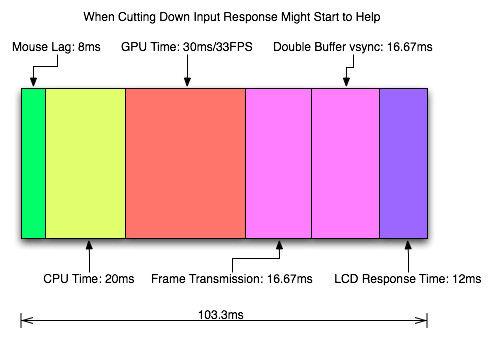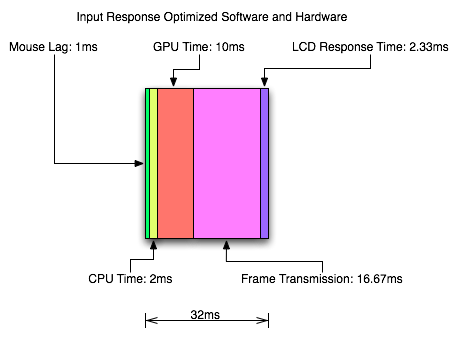Combating Input Lag and Final Words
Now that we know what's going on and what the factors are, what can we do about it?

Sometimes 1ms can be the difference between your input getting to the software in time to be included in the next frame. Most of the time it won't. Of course, the difference between 8ms and 2ms could actually make a frame of difference (up to 16.67ms) in input lag. A mouse that can handle 500 reports/second is what we recommend as a good balance.
It is possible to overclock your mouse. You will still be limited by the physical capabilities of the mouse, but running the USB port for the mouse at a higher rate can help, especially if you don't want to invest in a more expensive mouse. There are tools out there to both check your mouse report rate (with Direct Input Mouse Rate) and to change the rate by replacing the usb driver. When changing the rate on Vista SP1 or Windows 7, drivers will need to be signed. This can be accomplished by using testing signatures and forcing windows to load them. NGOHQ offers a good tutorial on this here.
CPU, memory and GPU will impact the input lag between the mouse and the display. The GPU, as the main internal bottleneck in games, will likely have the largest single impact (higher framerate means less time between frames and less lag), but this is heavily dependent on game design. The basic recommendation is a modestly priced dual core CPU, inexpensive RAM, and a fast GPU. Faster CPUs and RAM could potentially benefit but will not likely provide a huge return on investment in this case.
For input lag reduction in the general case, we recommend disabling vsync. For NVIDIA card owners running OpenGL games, forcing triple buffering in the driver will provide a better visual experience with no tearing and will always start rendering the same frame that would start rendering with vsync disabled. Only input latency after the time we would see a tear in the frame would be longer, and this by less than a full frame of latency.
Unfortunately, all other implementations that call themselves triple buffering are actually one frame flip queues at this point. One frame render ahead is fine at framerates lower than the monitor refresh, but if the framerate ever goes past refresh you will experience much more input lag than with vsync alone. For everyone without multiGPU soluitons, we recommend setting flip queue or max pre-rendered frames to either 1 or 0. Set it to 1 if framerate is always less than monitor refresh and set it to 0 if framerate is always greater than or equal to monitor refresh. If it goes back and forth, only NVIDIA's OpenGL triple buffering will provide the best of both worlds without tearing and will further reduce input lag in high framerate situations.
Improperly handling vsync (enabling or disabling a 1 frame flip queue at the wrong time) can degrade performance by at least one additional whole frame. But with multiGPU options, we really don't have a choice. With more than one GPU in the system, you will want to leave maximum pre-rendered frames set to the default of 3 and allow the driver to handle everything. Input lag with multiGPU systems is something we will want to explore at a later time.
You will want a monitor that doesn't do much (if any) processing. Preferably with a "game" mode. We recently took a look at a few monitors to get a feel for the difference in input processing. While we didn't test it in this article, adding another 16ms to 33ms to input lag is just not a good idea.

One of the largest benefits to games that don't inherently carry a lot of input lag is refresh rate. A real 120Hz refresh rate can significantly benefit input lag especially in twitch shooters. While that impact would be less in games where the framerate can't keep up, the hail of additional frames that can be incurred between the computer and the monitor will still be significantly impacted. Additionally, vsync (even in the worst case) is much cheaper on a high refresh rate monitor. Triple buffering (or even 1 frame flip queues with performance lower than refresh) and 120Hz monitors are a match made in heaven.
Final Words
What started out as a short article on the concept of input lag ended up touching on quite a few key issues in gaming. We get into a few of the concepts of game design and program flow in addition to looking at hardware impact. While we hadn't planned on it, picking up a camera that can do 1200 FPS allowed us to actually measure the input lag of a couple real games.
There are quite a few good nuggets to take away. First, input lag is hugely dependent on the game. There will be games that optimize for reducing input lag and others that do not. In some games it is more important than others. For games that incur huge amounts of input lag, there is only so much that can be done. Using the tips we provided will definitely help get people on the path to lower input lag.
Unfortunately, sometimes reducing input lag to its minimum requires spending money especially on the display side of things. Just make sure to read reviews that look at display lag as avoiding a display that adds an extra 16ms to 33ms of input lag is definitely a good start. Beyond that, a faster GPU is the next most important upgrade, and a mouse that can do at least 500 reports per second is a good idea.










85 Comments
View All Comments
RubberJohnny - Friday, July 17, 2009 - link
OT - I used to be a diehard CRT ONLY user then i realised there is NO ghosting on modern LCD monitors...you may have seen smearing on LCD tvs but thats caused but the scaler resizing SD material to fit the panels native res.On monitors there is no scaling = no ghosting.
Got a 24inch samsung 6 months ago and wish i'd done so earlier, crisper, larger image and widescreen being the main reasons i'll NEVER use a crt again.
DerekWilson - Friday, July 17, 2009 - link
I agree that with modern LCD panels ghosting is not as large an issue and color (depending on backlight) and contrast (depending on panel) are much better these days as well.Refresh rate is the only real outstanding issue these days (imo). And the only 120Hz display I saw was a bit over saturated / over bright and not high enough contrast.
jkostans - Saturday, July 18, 2009 - link
I have yet to see an LCD without ghosting, it may be minor but it's still annoying. And even the 120Hz LCDs supposedly still have measurable input lag regardless of the non-existent ghosting. LCDs are still a downgrade as far as I'm concerned.DerekWilson - Sunday, July 19, 2009 - link
Well you can actually see how much (or little) ghosting there would be in our high speed footage... even the advertised latencies on the 3007WFP are pretty bad compared to most panels these days (especially TN panels). Despite that there were only a few cases where we could see ghosting take a whole frame (and it never seemed to take more than a whole frame).We should test more panels with high speed cameras and see what happens...
Freeseus - Thursday, July 16, 2009 - link
I feel like there is a HUGE section of delay missing from this article. Perhaps it was chosen specifically not to be included because rigorous testing/comparison would have to be performed in order to show any sort of suggested "average" numbers. Either way, I feel it should have been addressed... even if it were just at the end of the article.I'm referring to the added delay of wireless mice.
Aside from the added delay of transmitting all the mouse action to the receiver, the biggest issue is the inconsistencies of mouse performance and precision. I'm sure there's a direct correlation between this and the battery. I'm referring specifically to the amount of battery used up in order for the mouse to broadcast continuously at extremely high intervals to insure precise movement. But obviously this includes any issue where the battery needs to be recharged as well. And on top of that, the mouse seems to be non-responsive occasionally during use. Completely unacceptable in a work or 'twitch gaming' environment.
Anyhow, it would have been nice to see this addressed because many people make the argument that wireless mice are better. And when it comes to FPS gaming or even work, I can't think of a reason not to have a wired mouse. Do I really need to have that accuracy all the time. Yes.
DerekWilson - Thursday, July 16, 2009 - link
I agree that the current state of wireless mice is generally pretty poor ... though I've never used a wireless mouse targeted at gaming (gaming mice were the first optical mice I was able to use without mousing too quickly for the sensor even during desktop use).Testing wireless mice is definitely something worth looking into.
Vidmar - Friday, July 17, 2009 - link
What about PS/2 mice? Are they better or worse than USB?DerekWilson - Friday, July 17, 2009 - link
PS/2 mice are slower ... iirc they come in at about 100Hz (10ms).Vidmar - Monday, July 20, 2009 - link
Really?? My old PS/2 MS Wheel Optical Mouse v1.1 is currently running at 200Mhz. IE: 200 reports/second. I've never felt like it doesn't keep up in any game.lopri - Thursday, July 16, 2009 - link
I'm loving this article and chewing threw every page right now. Just wanted to say thank you for such in-depth analysis as is rarely found elsewhere.